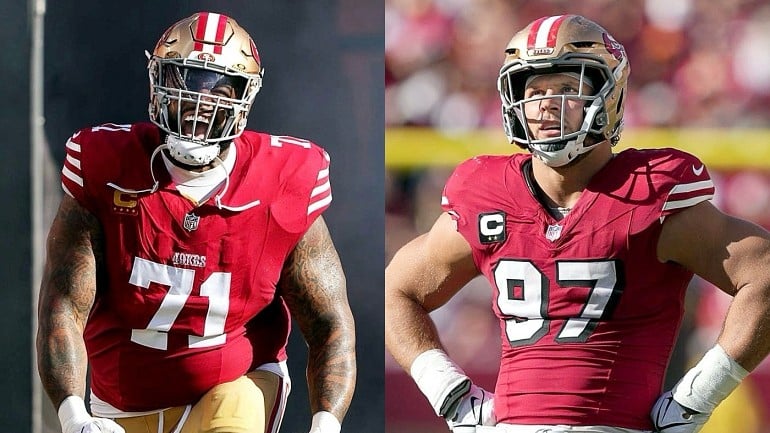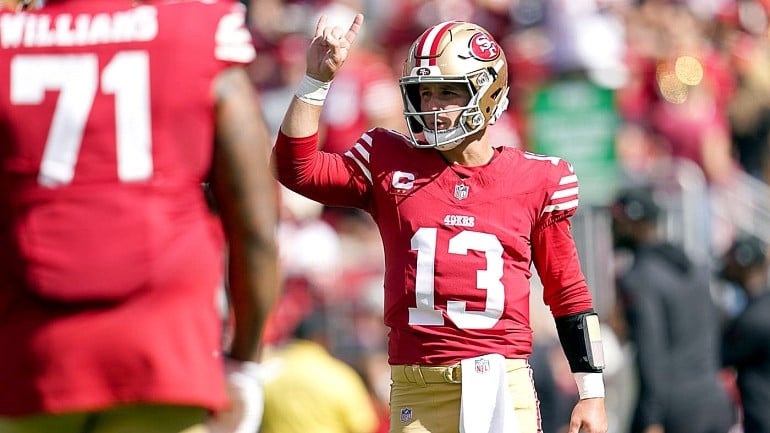The NFL offseason is a wild duality of celebration and sadness. Last week, 32 teams drafted 255 new players into professional football, while many veterans decided it was time to walk away from the game.
Unfortunately for the San Francisco 49ers, the team and the millions of fans had to say good-bye to 13-year veteran tackle Joe Staley. The 'will-he-won't-he-retire' rhetoric surrounding Staley seemed to be mild up until a few days before the draft.
I'm guessing 49er management knew Staley's intentions before the draft and put together a plan even Hannibal Smith would applaud. General manager John Lynch was able to drop back in the first round and obtain a blue-chip defensive linemen Javon Kinlaw. He waited until the third day of the draft to send a 2020 fifth-round pick and a 2021 third-round selection for All-Pro left tackle Trent Williams.
Williams is not new to head coach Kyle Shanahan's offense. He played his first four years in the system while Shanahan was Washington's offensive coordinator. Williams flourished despite Washington's bipolar win-loss record.
Shanahan's terminology might have slightly altered since Williams played in the offense. But the system's fundamental strategy and foundations, such as outside zone runs, pass protections, and movement plays, are still intact.
Here are five familiar plays and protections from Williams' best game in the 2013 season.
1st Quarter - 1st and 10 at the WAS 27 (14:52)
In case anyone needed a reminder, Shanahan rooted his system in the West Coast Offense. 'Lion' has been a West Coast term for decades, indicating a slant or double slant routes from the receivers. The seam routes from the 'Y' and 'U' receivers complement the play by pulling a linebacker or drawing down a jumpy safety, which then clears space for the slants.
'Scat' and 'Jet' protections are nearly identical; however, 'scat' gives the running back a free release into the play. The offensive line has no backfield help, and slides four men away from the call, leaving the left or right tackle in a one-on-one situation with the defensive end.
Shanahan uses 'Scat' and 'Jet' often; his offense cannot function without tackles that always need chip blocks or double teams to help secure the edge.
Too many tackles get swept aside when a defender gets in too close to his body. That does not happen with Williams. On this play, and throughout the game, he let his opponents into his body, and then easily pressed them away.
Williams had no problems with the New York Giants defensive linemen. He did not allow a sack, pressure, hit, hurry, or draw a penalty in the contest.
1st Quarter - 1st and 10 at the NY 17 (10:44)
Shanahan attacks the strong and weak sides of the offensive formation with a variety of zone runs. Some of his weak side zone runs are called 'Wanda,' and the 49ers run it with regularity.
'Wanda' has not changed since Shanahan was with Washington. Like today, the play is executed from a single-back formation to strike the edge of the weak side.
The offensive line uses outside zone rules to create space in the defensive line. In the play above, the run was going left, which means each offensive lineman looks to his left to determine if he is covered or uncovered.
An offensive lineman is covered when a defender is between the lineman's nose and the nose of the lineman to his left. The lineman is uncovered if that scenario is not occurring.
Williams was covered on this run, which meant he had to remove Giants' defensive end Mathias Kiwanuka from the gap.
Kiwanuka did not have a good evening against Williams, finishing dead last in overall defensive grading and tackling. The play above encapsulates how Williams neutralized his opponent.
2nd Quarter - 3rd and 7 at the WAS 44 (15:00)
If you have doubts about trading draft picks for a veteran left tackle with experience in Shanahan's offense, then take that load off and put the load right on me.
'300 Jet' told Washington's offensive line to slide away from the call and let Williams and the back pick up the left side of the line. It sounds easy, but minor nuances within each defensive front change the assignments.
The Giants' free safety was in the box just a few yards away from the Plug linebacker. That look told Washington's running back Roy Helu to read the Plug first and the free safety second. I'm guessing Williams, left guard Kory Lichtensteiger, and Helu worked a protection call like 'Gap' that told Helu to block the A-gap.
That left Lichtensteiger to take the free safety, and Williams alone to shore up the left edge.
2nd Quarter - 1st and 10 at the NYG 20 (13:26)
Shanahan's 'structure' rush plays are outside zone runs that attack the strong side of the formation. Keep in mind that zone run plays do not have a designated hole like a power or lead play. Backs read outside-in one gap at a time and to react to what he sees.
The slight unpredictability of a zone run can make it lethal. On this play, running back Alfred Morris was headed on an outside zone course, aiming for the outer leg of the tight end.
Notice the Giants' middle linebacker - he overshot his read, only to figure out the backside of the formation was left wide open.
Morris was lucky to have a tackle like Williams since nobody on the strong side could clear a lane. So, Morris looked to the backside of the play and immediately cut against the grain to gain five yards.
Once again, Williams made a mockery of Kiwanuka, driving him well off the line of scrimmage and completely neutralizing him as a threat to Morris.
4th Quarter - 1st and 10 at the WAS 36 (2:10)
Washington lost this game and had an awful 2013 season, but the screen play was too good not to include.
Tackles like Williams must salivate when they hear a wide receiver screen called to their side. If you're good enough, like Williams, it's a chance to get into an open field and bulldoze a small defensive back.
Williams was the second key block on a release screen and zeroed in on Giants defensive back Prince Amukamara. Sure, the play only gained five yards, but Williams demolished Amukamara - and then stood over him singing Amukamara's death song like a conquering hero headed home.
As much as I wanted Lynch to upgrade the interior positions on the offensive line, I'm thrilled he added Williams to replace Staley. Hopefully, the 49ers' habit of picking up offensive linemen off the free-agent scrap heap has finally ended.
All images courtesy of NFL.com.
All statistics courtesy of Pro Football Reference unless noted.
- Bret Rumbeck
-
Written by:Bret Rumbeck has been writing about the 49ers since 2017 for 49ers Webzone and 49ers Hub. He is a Turlock, CA native, and has worked for two members of the US House of Representatives and one US Senator. When not breaking down game film, Bret spends his time seeking out various forms of heavy metal. Feel free to follow him or direct inquiries to @brumbeck.




